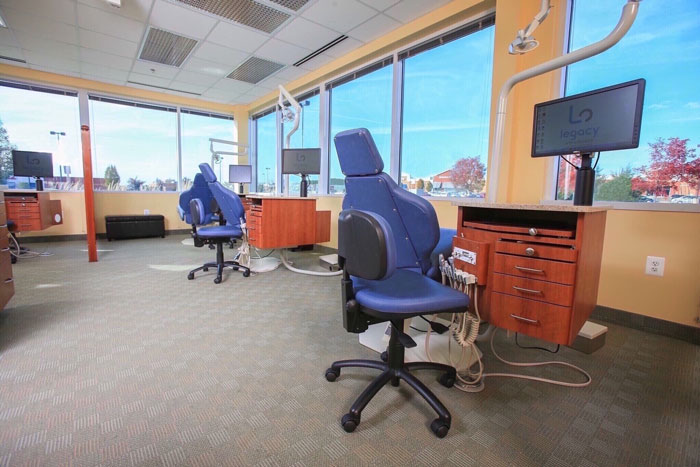Getting My Legacy Orthodontics To Work
Getting My Legacy Orthodontics To Work
Blog Article
The Definitive Guide for Legacy Orthodontics
Table of ContentsThe Greatest Guide To Legacy OrthodonticsAbout Legacy OrthodonticsAll about Legacy OrthodonticsLegacy Orthodontics Can Be Fun For AnyoneThe smart Trick of Legacy Orthodontics That Nobody is Talking About
At Advanced Orthodontics, we supply people with a all natural treatment experience. Additionally, we provide adjustable therapy timetables, adaptable settlement alternatives and a fun, satisfying experience. leesburg invisalign. Phone call ( 480) 357-4900 today to learn more and routine an appointment.An orthodontist is a dental practitioner educated to identify, prevent, and deal with teeth and jaw irregularities. Orthodontists work with individuals of all ages, from kids to adults.
Malocclusion, or misaligned teeth, can bring about dental issues, consisting of dental caries, gum tissue illness, and difficult or excruciating eating. Not every person is born with straight teeth. If you have a poor bite or big rooms between your teeth, you might intend to consult a dental practitioner focusing on orthodontic care.
An Unbiased View of Legacy Orthodontics
( Picture Credit Score: DigitalVision/Getty Images) Orthodontists utilize fixed and detachable dental devices, like dental braces, retainers, and bands, to transform the placement of teeth in your mouth. Orthodontic treatment is for dental abnormalities, including: Jagged teethBite problems, like an overbite or an underbiteCrowded teeth or teeth that are too far apartJaw misalignmentThe objective of orthodontic therapy is to improve your bite.
A healthy bite guarantees you can eat, eat, and speak correctly. While you might assume of orthodontists as primarily for youngsters or teenagers that require dental braces, they can correct oral issues at any type of age. Orthodontists attend university, dental school, and orthodontic school. After graduation, they spend 2 or 3 years in an orthodontic residency program.
All orthodontists are dental experts, however not all dental practitioners are orthodontists. Orthodontic residency programs provide extensive, concentrated instruction for dental specialists. They concentrate on two locations: Just how to properly and securely move teeth Exactly how to properly lead growth in the teeth, jaw, and faceOnce an orthodontist has actually completed training, they have the option to end up being board licensed.
Legacy Orthodontics Fundamentals Explained
Imbalance, or malocclusion, is one of the most typical reason individuals see an orthodontist. It is genetic and is the result of dimension differences between the upper and reduced jaw or between the jaw and teeth. Malocclusion results in tooth congestion, a misshapen jaw, or uneven bite patterns. Malocclusion is generally treated with: Your orthodontist attaches steel, ceramic, or plastic square bonds to your teeth.
Some individuals require a headwear to aid move teeth into line with stress from outside the mouth. A retainer is a personalized device that maintains your teeth in place.
They're usually used on youngsters. They can create additional area in the mouth without having to pull teeth. If you have a major underbite or overbite, you might need orthognathic surgery (likewise called orthodontic surgical treatment) to lengthen or see this reduce your jaw. Orthodontists make use of cables, surgical screws, or plates to support your jaw bone.
You may need to see an orthodontist if you have: Crowding or otherwise sufficient room for all of your teethOverbite, when your upper teeth come over your bottom teethUnderbite, when your base teeth are as well far forwardSpacing or concerns with gapsCrossbite, which is when your top teeth fit behind your base teeth when your mouth is closedOpen bite or a vertical gap in between your front bottom and top teethMisplaced midline, when the center of your bottom and top teeth do not align Fixing a dental malocclusion can: Make biting, eating, and talking easierImprove the balance of our face and your overall appearanceEase pain from temporomandibular joint conditionsSeparate your teeth and make them simpler to clean, helping avoid tooth decay or dental caries It's often a dental practitioner that first notifications misaligned teeth during a routine examination.
The 45-Second Trick For Legacy Orthodontics

During your very first orthodontic examination, you'll likely have: An oral examPhotos taken of your face and smileDental X-raysPanoramic (360 level) X-rays of your face and headImpressions to produce molds of your teethThese tests will certainly assist your orthodontist know how to wage your therapy. invisalign. An orthodontist is a dental practitioner who's had training to treat your teeth and jaw
An orthodontist is focused on your bite, so something like a cracked tooth would be handled by a dental professional. Orthodontists are focused on your bite, or the method your teeth fit with each other, and the straightness of your teeth.
Ever before asked yourself how stars always seem to have perfectly aligned teeth? The solution commonly hinges on the knowledgeable hands of an orthodontist. What precisely does an orthodontist do? Orthodontists are oral professionals that concentrate on dealing with abnormalities in the teeth and jaws. Their knowledge goes past just producing a gorgeous smile; it expands to improving your total oral health and function.
The 45-Second Trick For Legacy Orthodontics

, orthodontists have a diverse toolkit at their disposal. These tried-and-true braces make use of a system of braces adhered to the teeth and attached by cords.
Clear aligners, like Invisalign, are a preferred alternative for patients seeking a much more discreet therapy alternative. These removable trays are tailor-made to gradually shift the teeth's position. Headgear might be used in conjunction with braces or aligners to apply extra targeted forces, particularly for dealing with jaw discrepancies. In situations of narrow jaws, palatal expanders can be made use of to produce area for appropriate tooth placement.
Report this page